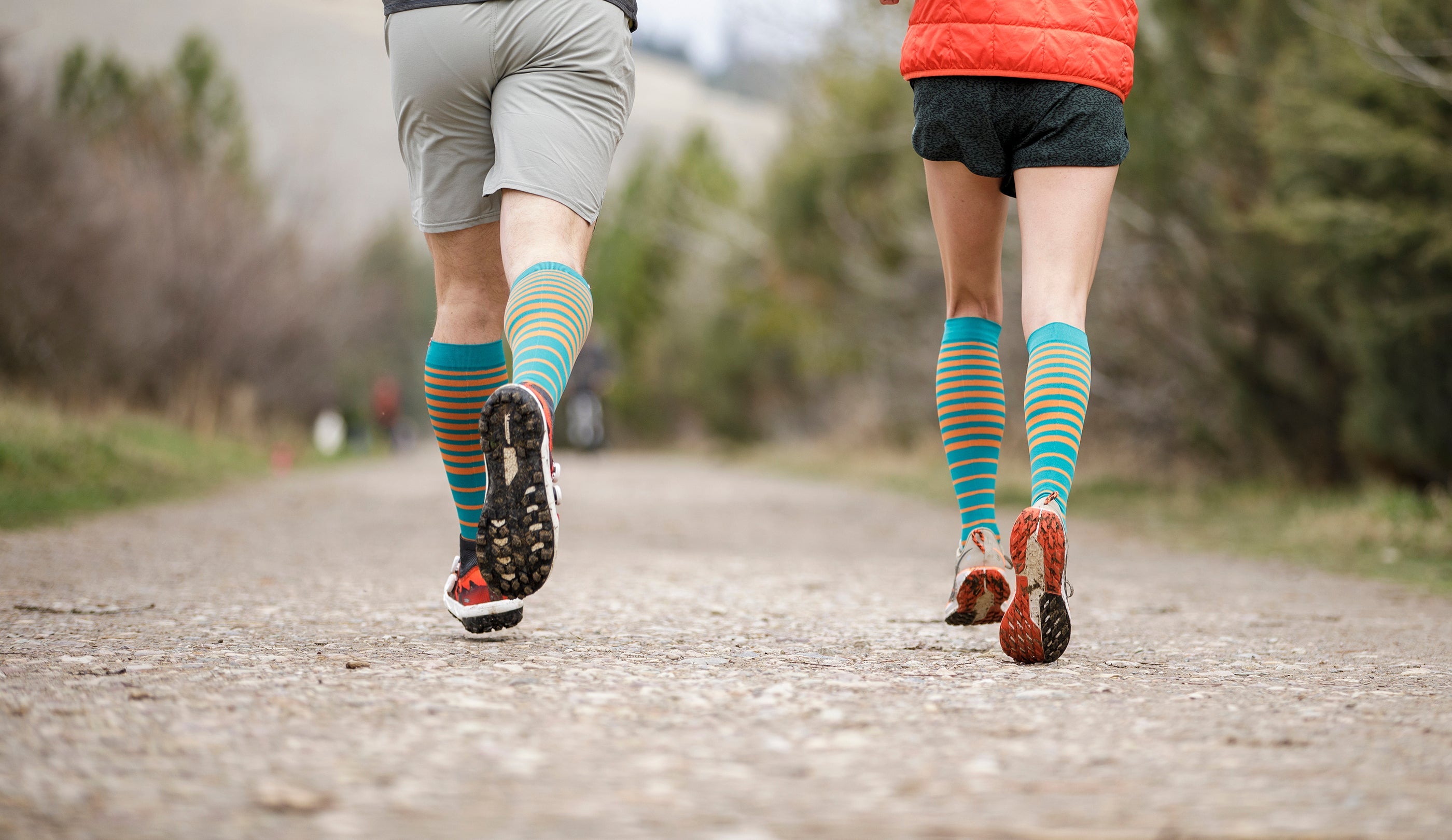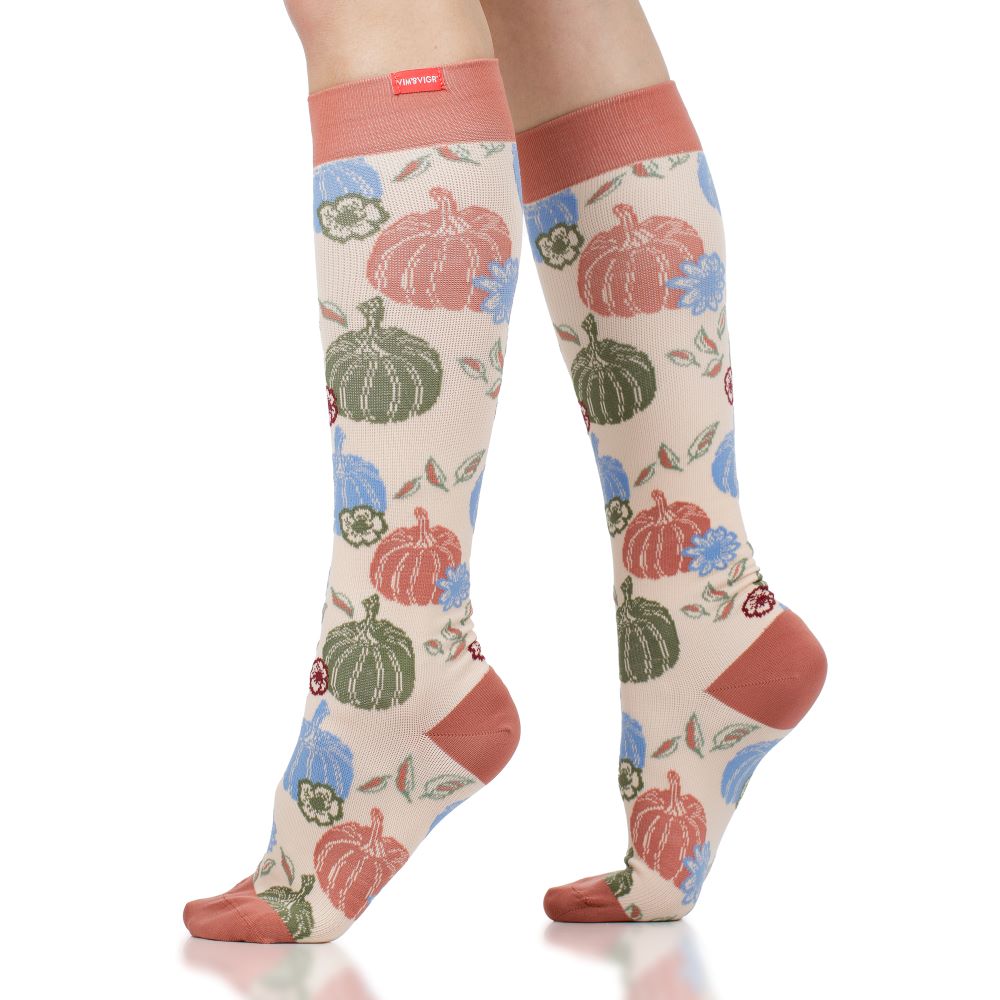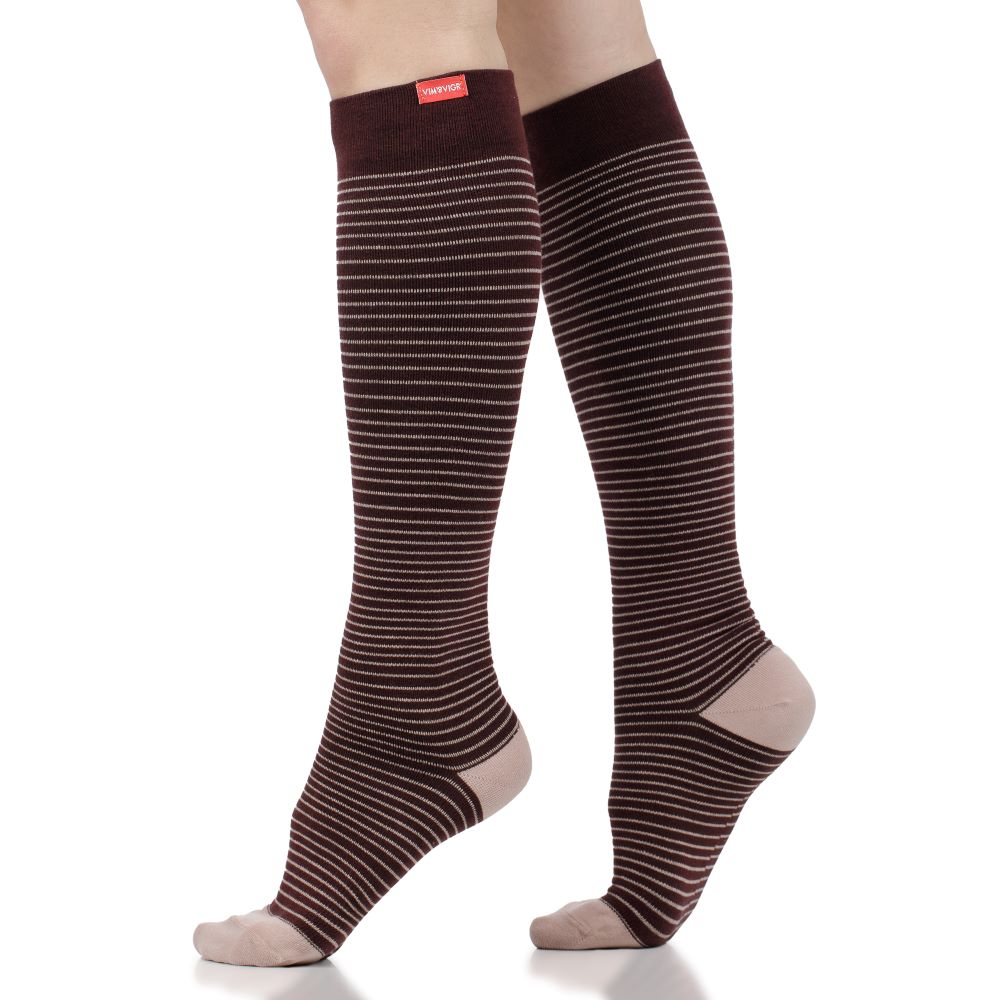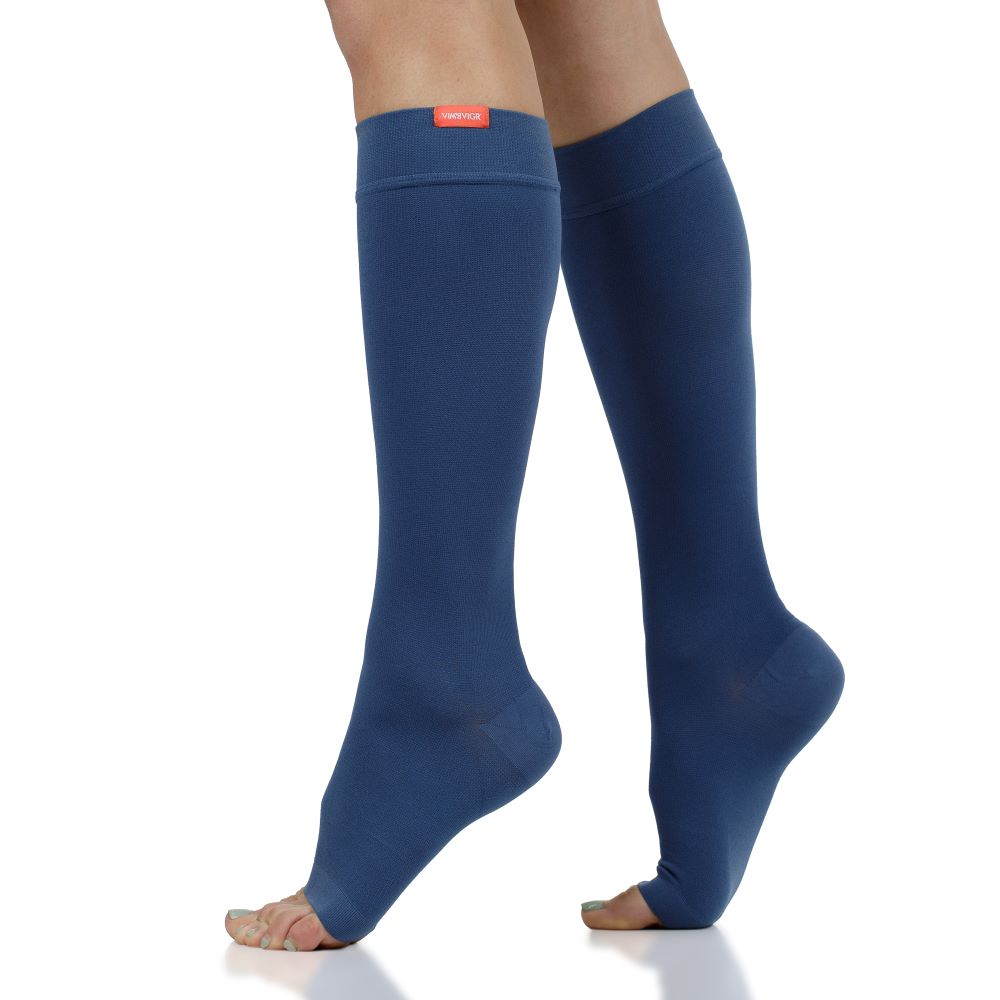Why Do Athletes Wear Compression Socks?
Whether you follow running, team sports like basketball or soccer, or have ever stepped foot into a sports shop, you’ll have seen compression socks at work. Athletes love compression therapy to get relief from aches and pains after a game or a race. Ultra runners often run in knee-high compression socks or use compression sleeves during races that last 12+ hours. And it’s not uncommon for athletes recovering from injury to use them, too.
So, why do athletes wear compression socks? Let’s do a deep dive into the benefits of compression garments, including how they can help during training, competition, and recovery.

Why Do Athletes Wear Compression Socks?
Compression socks can help improve blood flow to the lower legs, which is great for athletes. They can prevent too much muscle soreness after running or playing sports like tennis and basketball. They are also good for reducing the risk of injury and for supporting the joints, if that’s something you need. Here are some good reasons to wear compression stockings for athletes.
Improved Athletic Performance
In theory, the quicker oxygen is delivered to muscle cells (through boosted blood circulation), the better the endurance of those muscles gets. Instead of waiting to recover with compression and cold therapy after intense effort, many athletes wear compression socks during their activity to improve how they perform.
Moreover, using compression socks during an activity increases blood flow and decreases the chances of forming blood clots or pooling in the calf veins. This means that - for long activities - compression socks or sleeves can help delay the onset of soreness in the calf muscles. This is essential in keeping long-distance runners moving at their desired speed (see this study). It’s also great for basketball players, for example, who have to keep running and jumping during the game (putting even more stress on those calf muscles).
While studies haven’t conclusively linked athletic performance directly to wearing compression socks, their role in delaying soreness and in keeping legs fresh and energized through better blood flow indicates that they can be very beneficial to athletes’ endurance.
Increased Energy and Endurance
As legs are put under repeated stress during sports, they become sore as the muscles are strained and endurance and energy levels decrease. This is partly due to muscle strain, which can be countered to an extent by delivering nutrients and oxygen to them as soon as possible.
Since compression garments promote increased blood flow in the area they cover, socks are great for keeping blood flowing through the lower legs. Similarly, compression stockings or tights improve circulation throughout the whole of your legs. A systematic review has found that wearing compression stockings below the knee was sometimes shown to improve endurance and overall energy levels.
Reduced Muscle Soreness and Fatigue
Wearing graduated compression socks helps blood flow back up from the legs, promoting an increase in blood circulation in the entire body. This leads to more oxygen being delivered to muscles, which has been shown to delay the onset of soreness and fatigue.
Several studies have shown that wearing compression socks benefits muscle function indicators and perceived muscle soreness during the recovery period. That all starts during physical activity, allowing athletes to stay fresh during their workouts and to recover quicker afterwards.
Compression socks also help reduce swelling and fluid retention. For athletes who are on their feet a lot, especially during hot weather races, this is crucial. It reduces the likelihood of them feeling uncomfortable between sessions, improving their sleep quality and the speed of overall recovery (especially subjectively: who among us doesn’t just feel more energized when their legs are lighter and pain-free?).
Finally, thanks to helping reduce levels of muscle soreness, combating swelling and refreshing legs, wearing compression socks also reduces the time to recovery. This means that an athlete can go back to training at higher intensity quicker.
Reduced Risk of Injury
When running or playing high-impact sports, legs are subjected to muscle oscillation - vibrations that go through the leg when the foot hits the ground. Depending on the intensity of these vibrations, they increase muscle fatigue and the risk of microtrauma in the muscular tissues (according to this study). Compressing the muscle and improving its stability helps reduce the risk of pain and injury.
Moreover, compression socks help increase the stability of athletes’ ankles (marginally, but importantly). Stabilizing the ankles helps reduce the risk of sprains and strains.
Finally, athletes often suffer from sports-specific injuries like Achilles tendonitis or minor stress fractures in the feet and shins. Compression socks are prescribed to help improve their stability and reduce the risk of recurring injury when they return to running or other sports.
Improved Circulation, Blood Flow, and Oxygen Delivery
The main benefit from wearing compression socks is that they boost blood flow and benefit the overall circulatory system. Thanks to increased blood flow to the muscles, athletes can reduce the time they need to recover between sessions. This is because oxygen and nutrients are delivered quicker to key areas like the calf muscles (or quadriceps and hamstrings if wearing full-length compression tights). This all helps speed up recovery.
Increased Proprioception and Joint Stability
Thanks to the pressure applied in particular to the ankles, compression socks improve joint stability. This helps prevent injuries and supports recovery from sprains and strains. Compression socks also improve proprioception - activating the connections between the foot, ankle, and calf muscles. This helps the tendons better support the ankle. It’s particularly beneficial for those who run and jump or need to make lots of turns (like playing soccer, tennis, etc.).
How Do Compression Socks Work?
So, why is it that compression socks can provide all these benefits to athletes’ lower bodies? The answer is in the science behind these garments.
Compression socks apply gentle pressure to the lower limbs, massaging the muscles and contributing to stimulating blood flow in the area. Graduated compression means that they are tighter at the ankle, then gradually become less tight as you travel up towards the knee. It is this gradual release of pressure that helps send the blood back up towards the heart and increases blood flow in the lower legs. You can read more about the way compression socks work here.
Types of Compression Socks for Athletes
Wearing compression garments doesn’t just restrict athletes to socks. There are a number of items of clothing that can help reduce muscle tension and boost circulation. Here are the benefits of each of them.
Compression Stockings for Athletes
Whether you’re a professional athlete or amateur sports lover, you’ll have noticed that, sometimes, applying pressure to the muscles just below the knee isn’t enough. This is where compression stockings can make a difference.
For runners and mountain athletes in particular, supporting the quadriceps and hamstrings during recovery is essential. Compression stockings climb up to the groin, delivering pressure and blood flow boosting benefits to the entire leg.
Open-Toe Compression Socks for Athletes
Perhaps you’re planning to wear sandals, but still want the benefit of compression socks. Or maybe you have a toe infection or injury which means you’d rather keep your toes aerated. For these situations, open-toe compression socks are a great option. Athletes will wear them during recovery without needing to go to great lengths to keep their toes well ventilated. These socks are cool in warm weather and give you extra space if you suffer from bunions or hammertoes.

Compression Sleeves for Athletes
Sleeves are another great way to isolate the area where you are looking for the benefits of compression. Calf sleeves allow runners to still wear specific shoes and socks combinations that they’ve found to work for preventing blisters, for example. They’re also ideal for long distance events and for long hikes, where you may need to change your socks but want to keep the sleeves on.
Additionally, compression sleeves for athletes can be worn with flip flops during recovery, allowing you to ventilate your feet and even get a foot massage while you’re at it!
Compression Tights for Athletes
For full coverage on your lower body, including the glutes and hips, you can’t go wrong with compression tights. These provide compression benefits to the whole leg and lower body area up to your waist. They’re also perfect for layering under walking, running, or ski pants in winter for extra warmth and comfort.
How to Wear Compression Socks During Training, Competition, and Recovery
Although the biggest benefits from compression occur during recovery from competition or training, we’ve seen that athletes can also improve their performance and stability during physical exercise thanks to them. Here’s how and when to wear your compression socks for the best results.
When to Wear Compression Socks
Wearing compression garments during exercise helps keep your legs fresh and energized. Moreover, during long runs or intense workouts involving jumps and turns (like in team sports), compression socks and sleeves support your joints and reduce muscle oscillations, giving you a better feeling of support overall.
Compression socks can help reduce pain associated with shin splints, which is great for road runners, especially during long workouts. Moreover, by protecting your ankles, they’ll reduce any pain from long days out running or hiking.
However, the biggest benefit from wearing compression socks is during the recovery phase, as most studies have shown. Boosting blood flow to the muscles that have worked hard during a workout leads to them recovering quicker, allowing athletes to be in top shape for their next session or competition. Compression socks worn after training also prevent legs from swelling and hurting, delaying onset muscle soreness and improving long-term physical performance for athletes.
How Long to Wear Compression Socks
Athletes can wear compression socks, sleeves and tights for long stretches of time, as long as they’ve familiarized themselves with them properly beforehand. Good-quality compression socks are safe to wear for hours on end, so they can be used during long runs or matches. They can also be worn for several hours during recovery, or during sleep if needed.

The Best Athletic Compression Socks
How can you choose athletic compression socks that will relieve leg soreness and pain, while keeping you feeling fresh and energetic? There are a few aspects to check when choosing your socks.
Graduated Compression
Opting for graduated compression, where the socks are tighter around the ankles and slowly release pressure towards the knee, is the best way to boost blood flow for athletes. This is because, when you spend a long time on your feet, blood can pool around the ankles. Graduated compression socks help direct it back up towards the heart, keeping the circulatory system working at its best.
Compression Level
There are different levels of compression, so it pays to look into this before buying your first pair of compression socks. We advise starting with the lowest pressure levels (15-20 mmHg), which are comfortable but still firm enough to make a difference.
Once you’re comfortable with low pressure compression, you can go up a notch to 20-30 mmHg. For those recovering from surgery or addressing a particular medical condition, doctors can also prescribe high compression levels, also known as medical grade levels.
Size and Fit
It’s really important that athletes wear the right size compression socks to get the full benefit from them. This means measuring the legs correctly and following our size guide to pick the best fit.
Compression socks need to fit tightly, but not so tight that they become uncomfortable. The best athletic compression socks include enough elasticity to let you move freely while still working on delivering some pressure to the legs. At the other end of the spectrum, socks that are too loose might feel comfortable in the first instance, but they can roll down and become a real nuisance… not to mention that they won’t work!
Check out our size guide here and try different sizes if you think you’re in between, until you find the best fit for you.
Material
Finally, choosing the right fabric for your compression socks for athletes is also really important. Athletes need breathable fabrics that will keep their feet dry, in order to avoid getting blisters or irritations. Moreover, the best fabric needs to be flexible enough to allow for a good range of movement.
For runners and athletes in general, we recommend Nylon and moisture-wick Nylon for thin, stretchy socks that move with your body and are barely noticeable on the feet. And, for all-seasons temperature regulation and breathability, you simply cannot beat Merino wool socks.



















Leave a comment